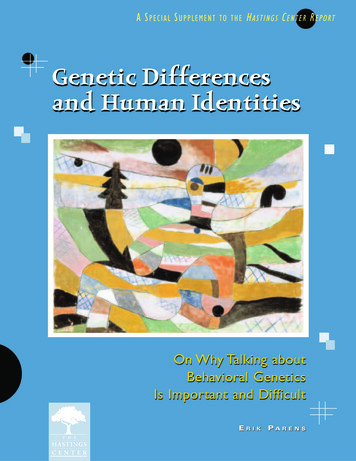
Transcription
A S PECIAL S UPPLEMENTTO THEH ASTINGS C ENTER R EPORTGenetic Differencesand Human IdentitiesOn Why Talking aboutBehavioral GeneticsIs Important and DifficultERIK PARENS. . . . .T. . H. . .E. . . . .HASTINGS.CENTER
AcknowledgmentsThis report is one product of a large project undertaken by The Hastings Center and the American Association for the Advancement of Science and funded by the Ethical, Legal, and Social Implications division of the National Human GenomeResearch Institute. Mark Frankel and Audrey Chapman (from AAAS) and I worked from the very beginning to develop the project and submit the grant application to NHGRI. From The Hastings Center, ErikaBlacksher, Mark Hanson, and Ashby Sharpe also participated in these early discussions. We could nothave completed the grant application, much less theproject, without the tireless, erudite, and wise adviceof V. Elving Anderson, professor emeritus of geneticsat the University of Minnesota. All of us who participated in this project owe Elving a great debt of gratitude.Once the grant was under way, Audrey, Mark, Elving and I were joined by Catherine Baker and NancyPress to form a steering committee that shared theresponsibility for making all of the decisions relevantto the project, from setting meeting agendas to identifying background readings, holding a public meeting in Washington, D.C., and creating a primer of behavioral genetics, a book of essays, and this report.Working with Nancy, Cathy, Audrey, Mark, and Elvingwas a pleasure and an honor.The steering committee was part of a larger working group, whose members are listed on the facingpage. On some topics, additional help was providedby consultants: Greg Carey (University of Colorado),Celeste Condit (University of Georgia), Carl Elliott(University of Minnesota), Elliot Gershon (Universityof Chicago), John Holmfeld (Science Policy Research), Steven E. Hyman (Harvard University), KayRedfield Jamison (Johns Hopkins University), TobyJayaratne (University of Michigan), Robert F. Krueger(University of Minnesota), Karen Lebacqz (PacificSchool of Religion), John Loehlin (University ofTexas), David Lubinski (Vanderbilt University),Jonathan Marks (University of North Carolina at Charlotte), Matt McGue (University of Minnesota), SueLevi-Pearl (Tourette Syndrome Association), Jo C.Phelan (Columbia University), John Rice (WashingtonUniversity), Janice Robinson (Grace EpiscopalChurch), Margo Smith (Depression and Related Affective Disorders Association), Eric Turkheimer (University of Virginia), and Irwin Waldman (Emory University).S2We were joined at one of our working groupmeetings by members of the United Kingdom’sNuffield Council, which has explored similar questions: Tom Baldwin, Martin Bobrow, Tor Lezmore,Yvonne Melia, Paul Pharoah, Martin Richards, andSandy Thomas.Administering such a complicated grant isn’t always easy. My colleagues and I are deeply gratefulto Joy Boyer at the ELSI office for her alwaysthoughtful, kind, and patient support of our work.Over the years of the project we benefited fromthe logistical support of Kevin Alleman, Rachel Gray,and Sharon Leu at AAAS and from the research assistance of Michael Khair, Alissa Lyon, SamanthaStokes, Marguerite Strobel, and Denise Wong at TheHastings Center. We also benefited from the large efforts of Vicki Peyton, Jodi Fernandes, and Mary AnnHasbrouck at the Center, whose work made our project meetings both productive and pleasant.Thanks to Jaime Bishop and Eric Trump for theirwork in the office of the Hastings Center Report.Thanks also to the Report’s art director, Nora Porter,for carefully reading and then creatively presentingthis report. Gregory Kaebnick, editor of the Report,edited this special supplement not only for style, butalso for content. It is wonderful to work with such atalented philosopher and wordsmith.In addition to Greg, several other people read theentire manuscript and made extensive comments:Elving Anderson, Troy Duster, Len Fleck, Irv Gottesman, Bruce Jennings, Nancy Press, and DavidWasserman.Finally, I want to thank Ken Schaffner, who notonly possesses extraordinary scientific knowledgeand philosophical understanding, but the generosityand patience to share it.So this report is truly the result of a large groupeffort. Even such a distinguished list of colleagues,however, could not save me from all errors of factand interpretation. In the end, responsibility for theerrors that remain is mine.On the cover: Awakening Woman, by Paul Klee. ARS, NYPhoto: Bildarchiv Preussischer Kulturbesitz/Art ResourceJanuary-February 2004 / HASTINGS CENTER REPORT
Project Working Group MembersV. Elving AndersonProfessor Emeritus, Genetics andCell BiologyUniversity of MinnesotaInstitute of Human GeneticsDivision of EpidemiologyCatherine BakerWriter/EditorPlain Language CommunicationsJonathan BeckwithAmerican Cancer Society Professor ofMicrobiology and Molecular GeneticsHarvard Medical SchoolDan W. BrockProfessor of Social MedicineDirector of the Division of Medical EthicsHarvard Medical SchoolAudrey R. ChapmanDirector, Science and Human RightsSenior Associate for Ethics, Dialogue onScience, Ethics, and ReligionAmerican Association for the Advancementof ScienceTroy DusterProfessor of SociologyNew York UniversityHarold EdgarJulius Silver Professor of Law, Science andTechnologyColumbia University School of LawLee EhrmanDistinguished Professor of BiologyState University of New YorkMarcus FeldmanProfessor of Biology SciencesDepartment of Biological SciencesStanford UniversityLeonard FleckProfessor, Philosophy and Medical EthicsMichigan State UniversityMark FrankelDirector, Scientific Freedom, Responsibilityand Law ProgramAmerican Association for the Advancementof ScienceIrving GottesmanBernstein Professor in Adult PsychiatrySenior Fellow in PsychologyUniversity of MinnesotaBruce JenningsSenior Research ScholarThe Hastings CenterKenneth F. SchaffnerUniversity Professor of Medical HumanitiesProfessor of PhilosophyGeorge Washington UniversityRobert WachbroitResearch ScholarInstitute for Philosophy and Public PolicyUniversity of MarylandRick WeissScience ReporterThe Washington PostGregory E. KaebnickEditor, Hastings Center ReportAssociate for Philosophical StudiesThe Hastings CenterPatricia KingCarmack Waterhouse Professor of Law,Medicine, Ethics and Public PolicyGeorgetown University Law CenterYvette MillerChief Medical OfficerArizona Region Blood ServiceAmerican Red CrossThomas MurrayPresidentThe Hastings CenterErik ParensSenior Research ScholarThe Hastings CenterKaren PorterExecutive DirectorCenter Health Law and PolicyBrooklyn Law SchoolNancy PressProfessorSchool of Nursing and MedicineOregon Health & Science UniversitySPECIAL SUPPLEMENT / Genetic Differences and Human Identities: On Why Talking about Behavioral Genetics Is Important and DifficultS3
BGGenetic Differences andHuman IdentitiesOn Why Talking about Behavioral GeneticsIs Important and DifficultBYER I KPAR E N SANew York Times headline announces, “FirstGene for Social Behavior Identified inWhiskery Mice.”1 “Attention-Deficit Gene IsLocated,” asserts a headline in the Wall Street Journal.2A Case Western Reserve University press release declares, “Researchers Discover Anxiety and AggressionGene in Mice.”3 Myriad Genetics Inc. proclaims thatthe company “has discovered a novel gene that causeshuman obesity.”4Some of this “gene-for” language is run-of-the-millhype. The language is intended to attract attention,and ultimately dollars.5 Some of it, however, is shorthand to communicate new findings that researchersbelieve may help explain why people behave the waythey do.6 One aim of this report is to help the readerget beyond the extravagant claims to begin to appreciate what behavioral geneticists hope to find and whatthey have—and have not—found.Because behavioral genetics aspires to illuminatehuman behavior, it raises questions about human freedom. What does knowledge about the influence ofgenes on behaviors mean for my belief that I am freeto choose particular actions? Am I free to choose thequalities of my temperament, like how sunny or empathic or outgoing I am? Should increasing knowledgeof genetics affect a criminal court’s proceedings? Andso forth.Because behavioral genetics investigates genetic differences, because it aspires to understand how differErik Parens, “Genetic Differences and Human Identities: On WhyTalking about Behavioral Genetics Is Important and Difficult,” Hastings Center Report Special Supplement 34, no. 1 (2004): S1-S36.S4ences at the level of the gene are related to differencesin traits, it also raises questions about human equality.Would it affect our understanding of moral equality ifwe learned that genetic differences help to explain whywe behave and appear differently, if we learned, for example, that some individuals are genetically predisposed to antisociality or hypergenerosity, alcoholismor teetotaling, low intelligence or high?Questions about human freedom and equality areultimately questions about our self-conceptions or“identities.” Thus we need to understand not only thefacts that behavioral geneticists present to us, but alsowhat those facts mean for our self-conceptions.With a generous grant from the Ethical, Legal, andSocial Implications program at the National HumanGenome Research Institute, The Hastings Center andthe American Association for the Advancement of Science undertook a three-year project called “CraftingTools for Public Conversation about Behavioral Genetics.” Over the course of the three years, the project’s working group came together five times formeetings spanning several days. We also spent countless hours in e-mail conversations. The working groupwas made up of people who do the science for a living,people who think about the history, sociology, andethics of the science, and a variety of others. Nobodyassumed that molecular biologists or doctors wouldlearn the finer points of law or philosophy or that thelawyers or philosophers would learn the finer points ofmolecular biology. All we assumed was that everyonebrought to the table a commitment to engage in anopen and respectful conversation.January-February 2004 / HASTINGS CENTER REPORT
Our group’s highly interdisciplinary work was facilitated by the work of many others.7 But in spite of all the excellent work already done and the good will brought tothe table, our conversation was sometimes difficult. We setout to create tools for public conversation, but underestimated how difficult it would be to conduct a fruitful conversation among ourselves. Much of this report exploreswhy it can be difficult to talk about what behavioral genetics has so far found and what those findings mean.Altogether unsurprisingly, one difficulty was that working group members came from different disciplinary backgrounds. Those of us from the humanities were sometimesintimidated by the languages of statistics and genetics.Sometimes the behavioral geneticists were frustrated thatthose of us in the humanities and social sciences did nottake more time to learn the science. The behavioral geneticists also sometimes seemed (to this “humanist,” anyway) impatient with the languages and concerns of scholars in the humanities and social sciences.A second and more surprising difficulty was that therewas not always agreement about the facts (not all of whichare in, of course). For example, behavioral geneticists tryto distinguish between two classes of environmental effects: those that make siblings in the same family alike,called "C," and those that make siblings different, called"E." Besides debating the relative magnitudes of C and E,behavioral geneticists disagree about the nature of the environmental processes that constitute these broad classes.The problem is particularly acute for E. This class is defined as comprising everything that might make a pair ofidentical twins raised in the same family different fromeach other. But behavioral geneticists offer two differentaccounts of what E is like. Some argue that it will turn outto be orderly: despite being raised in the same family, thetwins' environments differ in systematic ways, leading tosystematic differences in their behavior. Their parents treatthem differently, for example, or they go to differentschools. Others argue that the critical environmental differences are unsystematic and hard to predict.These two accounts suggest very different prospects forscientific investigation. If systematic differences are key, itshould be possible to measure those differences and tracktheir effects.8 But if the important differences are unsystematic, it will be possible to observe their total effect butdifficult to identify the individual processes.9 As I will suggest later, there is a parallel and equally important debateamong behavioral geneticists about the likelihood of identifying the systematic effects of individual genes on behaviors.Disagreements like these are an inevitable product ofintellectual integrity and can be a source of scientificprogress. They can also, however, make assessing the scientific claims especially difficult for nonscientists.Finally, our working group conversation was difficultbecause, of course, nobody comes to the table withoutfeelings about what the facts should be. Nor can these feel-ings be divided neatly between scientists and humanists.During our meetings, it seemed that some from both sidesof the disciplinary divide fervently wanted genetic differences to go a long way toward explaining behavioral differences, and some from both sides equally fervently wanted genetics to be of rather little use. If a given genetic finding might suggest that genetic differences can play an important role in explaining variation in intelligence, or novelty seeking, or sociality, then that finding seemed to gladden some people as it simultaneously depressed others.Why these intense feelings? Because in some cases, Ithink, no less is at stake than human identities and theproper organization of societies. To what extent are whatever privileges people enjoy the consequence of naturalgifts instead of luck and “gifts of nurture”? Does our current social order reflect the way things are “by nature”meant to be? Or does it reflect the contingent effects ofpower-seeking animals? Is it an inexorable fact of nature,or a contestable product of human choices? Ultimately, towhat extent are current forms of inequality rooted in natural differences, and to what extent in human intentions?Few issues inspire as much feeling.Given that no less than how we understand ourselvesand how we think we ought to organize our society seemto be riding on how we interpret the findings of behavioralgenetics, it is not surprising that the conversation aboutthose findings is sometimes difficult. But it is a conversation we would benefit from sharing in. I hope this report,aimed at readers with a passing knowledge of high schoolgenetics but no knowledge of behavioral genetics, willmake a small contribution to others as they embark upontheir own conversations.In part 1, I introduce the reader to the sorts of questions that contemporary behavioral geneticists aim to answer. I emphasize that, whereas many kinds of scientistsseek to understand what is normal or typical for a memberof a species, behavioral geneticists seek to understand whyindividuals are different from each other with respect tosome trait. I then give some historical background, suggesting that efforts to explain human differences have alltoo often accompanied efforts to justify why some individuals (or groups) enjoy more social power than others.In part 2, I introduce the basic methods behavioral geneticists use to try to understand how genetic differencesare related to observable or phenotypic differences. I introduce the “classical methods” of behavioral genetics, whichbegin with twins to try to determine how much of thephenotypic variation in a population is due to genetic variation; I take considerable time to show how the key “classical” concept of heritability has been misunderstood andabused. I also introduce the newer “molecular methods,”which aim to identify particular genes that influence particular traits. I emphasize that behavioral geneticists themselves increasingly attend to the fundamental fact that observable traits emerge out of the staggeringly complex andconstantly changing interactions among genes and envi-SPECIAL SUPPLEMENT / Genetic Differences and Human Identities: On Why Talking about Behavioral Genetics Is Important and DifficultS5
ronmental factors. I also emphasize that thus far, efforts toidentify specific genes that help to explain specific observable traits or phenotypes have not yielded nearly as muchas the newspaper headlines have promised or the researchers have hoped.In part 3 I explore how inquiries into behavioral genetics might affect our ideas about freedom and equality andultimately our self-conceptions or “identities.” I say why Ithink genetics does not offer information that shouldthreaten our experience of ourselves as free. And I suggestthat inquiries into genetic differences can be misappropriated by those who want to justify inequalities in the distribution of social power. Unfortunately, such misappropriation is a constant risk.In part 4 I identify some of the obstacles that will faceothers who try to converse about what behavioral geneticists believe are the facts and what those facts mean.In sum, I try to give a fair account of what behavioralgeneticists have and have not discovered. I try to makeclear how the facts they aspire to discover can be put to thepernicious purpose of justifying the status quo. And I tryto make clear how the individual differences perspective ofbehavioral genetics can be put to the salutary purpose ofaffirming human genetic variation. Ultimately, this reportis no more nor less than an invitation to others to share ina conversation about what the findings of behavioral genetics mean.Part 1 CONTEXT The “Individual DifferencesPerspective”Behavioral genetics versus medical geneticsThe field of behavioral genetics studies the genetic influence on complex human traits, which as Ken Schaffnerputs it include “virtually any described or measured featureof an organism, including behaviors.”10 But the field ofmedical genetics also studies the genetic influence on complex traits. Roughly, medical genetics studies the geneticinfluence on those traits or behaviors that traditionallyhave come within the purview of medical doctors—cancer, diabetes, hypertension. Behavioral genetics studies thegenetic influence on those traits or behaviors that traditionally have come within the purview of psychologists(and psychiatrists). Those traits include both “mental disorders,” like bipolar disorder and schizophrenia, and various cognitive disabilities, including those associated withreading and speech. Psychologists have also traditionallystudied behaviors and traits like intelligence and aggressiveness, and so do behavioral geneticists.The border between medicine and psychology is fuzzyand changing, however. Depression was once squarelywithin the purview of psychologists and psychiatrists butincreasingly is within the purview of internists as well.Many researchers in medical genetics study Alzheimer’s,but now so do researchers in behavioral genetics. Whilethe departmental names may be different, when it comesto the newer molecular approaches, the research andmethodological questions are largely the same.Classical versus molecular approaches tounderstanding genetic influencesAgain, many behavioral geneticists today use the same“molecular methods” employed by medical geneticists.S6That is, both groups use DNA-based science and technology in their efforts to identify the genes that are associatedwith a variety of traits and disorders. But it is important tounderstand that before the molecular methods becameavailable, behavioral geneticists used (and still
project, without the tireless, erudite, and wise advice of V. Elving Anderson, professor emeritus of genetics at the University of Minnesota. All of us who partici-pated in this project owe Elving a great debt of grati-tude. On

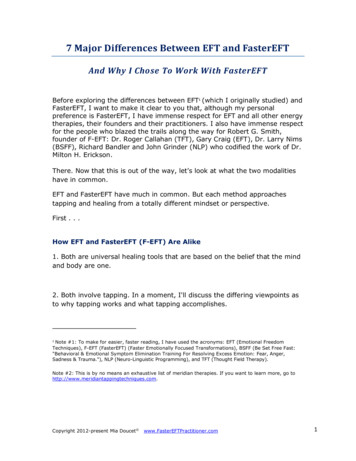

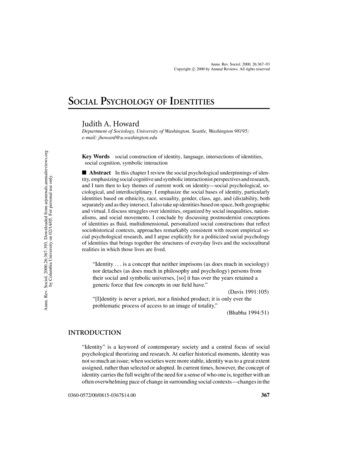



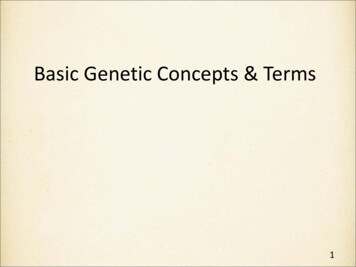


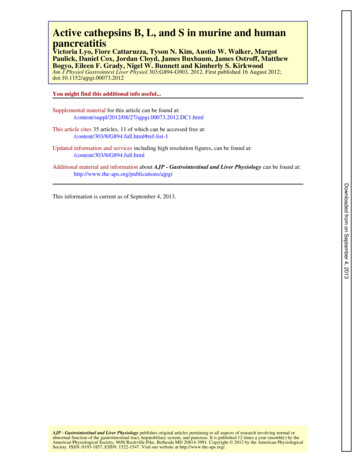
![[IV‐ADV‐9‐A] Tips and Tricks for Payroll and Human Resources](/img/9/tips-and-tricks-payroll-and-hr.jpg)